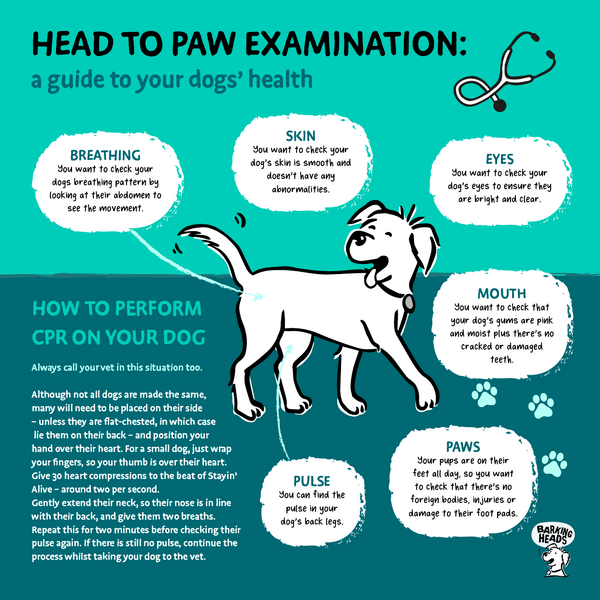Head to Paw Examination: an at-home guide to your dog’s health

Head to Paw Examination: an at-home guide to your dog’s health
Like humans, dogs can show illness through simple actions, but they can’t share their feelings as quickly as their owners - so home check-ups between vet visits are essential.
Remember, these checks won’t replace vet visits but could give you some insight into your dog's health from home. If you find something abnormal or feel like your pup is in pain (check out Dr Scott’s tips on how to tell if your dog is in pain), contact your vet for a professional opinion.
Here’s our barking-mad vet Dr Scott Miller’s guide to giving your dog a head-to-paw examination.

Where can I feel my dog’s pulse?
To find your dog's pulse at rest, look for their femoral artery (in the groin). Then, press your fingers from inside the groin towards one leg, count the pulse over 15 seconds and multiply by four to find the pulse rate per minute.
What could be wrong with my dog’s mouth?
Your dog’s gums hold a lot of information about their health. For example, blue-tinged gums indicate low blood oxygen levels or may show your dog has hypothermia.
The non-pigmented areas of the gum should be pink. If they are any other colour, there may be an underlying issue.
What to do
Gently pull your dog's lips over its teeth and check the capillary refill time (CRT). To do this, you press the pink gum and assess how long it takes to return to pink. One to two seconds is normal.
🐾 Bonus
Check for cracked or damaged teeth in your dog’s mouth and sniff your dog's breath. It may be a sign of periodontal disease if it has a nasty odour. This may mean a trip to the doggy dentist (vet) for a dental procedure.
How do I check if my dog’s breathing?
Assess the movement of the abdomen, which is located below your pup’s ribcage towards their hind legs, to check for breathing as it moves far more than the chest cavity.
If unsure whether your dog’s breathing is irregular or whether they’re breathing at all, hold hair or grass in front of their nostrils, and the grass should flicker…if they eat the grass, they are definitely breathing!
If you find that your dog isn’t breathing, here is how to perform CPR on your dog – but remember, you should always call your vet in this situation too.
Although not all dogs are made the same, many will need to be placed on their side – unless they are flat-chested, in which case lie them on their back – and position your hand over their heart. For a small dog, wrap your fingers so your thumb is over their heart.
Give 30 heart compressions to the beat of Stayin’ Alive – around two per second.
Gently extend their neck so their nose is in line with their back and give them two breaths.
Repeat this for two minutes before rechecking their pulse. If there is still no pulse, continue the process whilst taking your dog to the vet.
What can a dog’s eyes tell you?
Dogs' eyes should be bright and clear. There may be a small amount of discharge around the eyes, which is typical for some breeds.
What to do
Look out for green or yellowish discharge from the eyes, excessive watering, or a red or pink tinge to the whites of the eyes – a trip to the vet could be necessary in this case.
What skin conditions do dogs get?
When checking for abnormalities, the skin should be smooth and loose and glide effortlessly over the underlying muscles. Note any skin abnormalities and look for fleas and ticks while you look over their skin. Next, massage your dog by running your hands down their chest, back, and belly.
Some grain free dog food diets have been seen to help with your furry friend’s skin and coat, giving skin a healthier feel and shiner coat.
Check for parasites and inflammation or injury too.
What's wrong with my dog's paw?
Check for any damage or cause of irritation on your dog’s feet and pads. Carefully look at your pup's paws and assess whether their foot pads are cracked or torn, and have a look to see if there’s any swelling or redness between the toes. Foreign bodies like grass seeds or grit also can cause irritation to serious injury, but can be simply removed by you if spotted early.
Check if their nails are too long – your dog's toes should hover around 1mm off the ground, not making contact unless they’re moving.
Also, be sure to check up on your pup’s paws more regularly during hotter months, as your dog may get burnt paws from walking on the pavement. For more advice, learn how to take care of your dog’s paws in summer with Dr Scott.
Puppy problems
Knowing how to check your dog’s health is essential, but also knowing what your new puppy may be susceptible to is just as crucial. These are the common diseases puppies may fall ill with that you must watch out for.
If you suspect your puppy of having any of these, get in touch with your vet.
Distemper
What is distemper?
Canine distemper is a highly contagious virus that affects dogs and other animals. It’s rare in the UK but affects young puppies and unvaccinated dogs.
How does it spread?
It is transmitted through airborne particles and contaminated surfaces.
What does it affect?
Distemper mainly attacks the respiratory, gastrointestinal and nervous systems of dogs.
Symptoms
Yellow-coloured diarrhoea, discharge from the eyes and nose, trouble breathing, weakness, loss of balance, abnormal movement and lethargy. Puppies may also have seizures or seem weaker or less coordinated than usual.
Kennel cough
What is kennel cough?
Kennel cough is a respiratory infection that affects dogs.
How does it spread?
Airborne particles of the bacteria Bordetella bronchiseptica.
What does it affect?
It affects your dog's respiratory system, causing them to cough.
Symptoms
A dry cough. Puppies may also have a high temperature, lethargy, and reduced appetite.
Parvovirus (Parvo)
What is parvovirus?
Parvovirus – known as Parvo – is a highly infectious disease that attacks a dog's intestine cells. Unvaccinated puppies under six months old are more vulnerable.
How does it spread?
Direct and indirect contact with infected dogs or a person touching something infected. The virus can survive in an environment, like your home or car, for up to a year and is highly contagious.
What does it affect?
Parvovirus affects your dog’s stomach by attacking the cells in its intestines. At its core, it is a highly contagious tummy bug.
Symptoms
Vomiting, diarrhoea (often bloody and smelly), fever, lethargy, weight loss, dehydration, weakness, and a depressed demeanour.
If you’re unsure what doggy diarrhoea looks like, check out our guide on your dog’s poo from our vet Dr Scott Miller.
Leptospirosis
What is leptospirosis?
Leptospirosis is an infection that attacks a dog’s bloodstream. Unvaccinated puppies are at greater risk. This illness can be spread to humans as Weil’s disease.
How does it spread?
It spreads through infected water or contact with infected animals or their bodily waste.
What does it affect?
Leptospirosis can permanently affect your dog's liver and kidneys, even if they survive the initial infection.
Symptoms
The symptoms are not present in all cases but can include fever, jaundice, weakness, and a reduced appetite.
Adenovirus – hepatitis
What is adenovirus?
Canine adenovirus is a virus that affects dogs' organs. Young, unvaccinated dogs are more susceptible to it.
How does it spread?
This can be spread from direct or indirect contact with an infected dog.
What does it affect?
It can attack the kidneys, eyes, lungs, heart, liver, blood and immune system, leaving your pup worn out with some nasty symptoms.
Symptoms
Lethargy, coughing, vomiting, diarrhoea, and reduced appetite. Severe cases may include high temperature and pale or yellow gums, and small red dots on the skin or gums.
Puppy vaccines
A common thread with some of these illnesses is puppies not being vaccinated. Ensure your precious pup is up to date with its vaccines and medicines to keep its immune system strong. You should also ensure your puppy is eating a nutritious, balanced diet to aid in healthy growth. We have dry puppy dog food and wet puppy food, formulated with all of the extra vitamins and minerals needed to support growth which is suitable for small breed puppies and large breed puppies.
Standout doggy illnesses
Keeping your dog healthy in the critical first years is essential, but keeping up with it is just as crucial. Here are some common illnesses to look out for as your dog grows into an adult.
Ringworm
What is ringworm in dogs?
Although it is called ringworm, it is a fungal infection which produces infective spores that can live for years on dogs’ skin, with just one spore able to cause the infection.
How does it spread?
It spreads through direct contact with the fungus that causes it, either from contaminated objects or another infected dog or human.
Symptoms
Hair loss with a crusty covering on the area. The lesions are most likely to appear on dogs’ heads, ears, paws and legs but can affect any part of the body.
Treatment
Once you have seen the vet and been directed to the proper treatment, you should thoroughly clean your dog's environment and deep clean their bed, bedding, toys and food/water bowl.
Heartworm
What is heartworm in dogs?
Heartworm is a parasite that lives in your dog's heart. These worms can travel from the initial entry point through the bloodstream all the way to your dog's lungs and heart chamber.
How does it spread?
Heartworm spreads through infected mosquito bites, which leave larvae that grow into heartworms.
Symptoms
Difficulty breathing, coughing, vomiting, weight loss, listlessness, and fatigue after a short amount of exercise. Some dogs exhibit no symptoms until the later stages of infection.
Treatment
To receive treatment, go to your vet for a thorough examination to determine the best medicine for your dog.
Lyme disease
What is Lyme disease in dogs?
Lyme disease in dogs is a bacterial illness from the bacteria borrelia bergdorferi. It affects your dog's joints, and in some cases, it can affect the brain and heart of your dog.
How does it spread?
This disease is spread through infected ticks.
Symptoms
Fever, loss of appetite, reduced energy, lameness (can be shifting, intermittent, and recurring), general stiffness, discomfort, or pain in and swelling of joints. Symptoms can progress to kidney failure, which can be fatal.
Treatment
In most cases, your vet will prescribe antibiotics to eradicate the bacteria.
Senior dog issues
Like puppies and adult dogs, senior dogs need some extra care in their older age. However, they also require a diet that helps support them in their older age; our senior dog food is formulated to help support joints, including some tasty wet food for senior dogs. Here are some things to look out for in senior dogs.
Arthritis
What is arthritis in dogs?
Arthritis is common in ageing dogs, as it comes from the wearing down of cartilage in their joints. This causes discomfort and pain in the joints of your senior pooch.
Symptoms
A change in how your dog walks, limping, reluctance to move, difficulty standing or walking and showing pain when picked up. Sometimes, a dog may lick or chew the aching area to show irritation.
Adjustments
There is no cure, but there are ways to reduce the pain and slow the progression of the disease. In addition, nutrition plays a big part in supporting your dog in later life. You can also try adding more vitamins and fatty acids into their diets with nutritional dog food for senior dogs high in these ingredients as these may aid in joint support. Our senior dog food is made with a special formula to help with strong joints.
Kidney disease
What is kidney disease in dogs?
With older age, dogs' kidneys tend to lose their function. Sometimes, the loss of function can lead to chronic kidney disease.
Symptoms
Drinking excessively and urinating more frequently, soiling in the home due to the larger volumes of urine, vomiting, diarrhoea, loss of appetite, weight loss, pale gums (caused by anaemia), and ulcers in the mouth.
Adjustments
Regular visits to your vet for blood work can help you catch kidney disease early. Your vet can then suggest a course of treatment to help your dog.
Deafness
What is deafness in dogs?
Like humans, with age, dogs can gradually lose their hearing. This is due to cell and nerve degeneration.
Symptoms
Dogs may seem confused or fail to respond to calls.
Adjustments
Try training methods that include hand signals to replace vocal prompts.
Vision loss
What is vision loss in dogs?
With age, dogs can suffer a gradual loss of vision. This may be from general degenerative changes to the eye, but in some cases, it can be caused by issues like cataracts.
Symptoms
Bumping into furniture, having trouble locating food or toys, and not meeting your eye when you try to make eye contact. In some cases, dogs may show a new reluctance to jump on or off the couch due to anxieties from eyesight loss.
Adjustments
When walking your dog, keep them on the lead. In the house, try not to move furniture around so the dog can learn to move around your furniture.
Cognitive dysfunction
What is cognitive dysfunction in dogs?
Like with humans, there is a chance that as your dog ages, it may exhibit signs of cognitive dysfunction, similar to dementia or Alzheimer's.
Symptoms
Disorientation, confusion, pacing/wandering, standing in corners as if lost, going to the wrong side of an opening door, vocalisation, withdrawal/not interacting with family as much, urinary/faecal accidents, change in sleeping patterns and restlessness.
Adjustments
If you suspect your dog has cognitive dysfunction, contact your vet for professional advice on the best course of treatment.
Gum disease
What is gum disease in dogs?
Gum disease is when the gums become inflamed after mouth bacteria becomes plaque on your dog's teeth and spreads under the teeth.
Symptoms
Bleeding or tender gums that may appear red and swollen. In some cases, the infection of bacteria can enter the bloodstream and cause further damage.
Adjustments
Regular brushing in the inflammation stage can help curb gum disease, but when the plaque reaches under the teeth, a trip to have the plaque removed may be advised by your vet. You can also try feeding them a mix of wet food for senior dogs and grain free dog food as it would be softer on your dog's gums when eating as the wet food would soften the kibble for them.
As your dog ages, getting the proper nutrition is just as important as keeping active and up to date with vaccines, especially when nearing old age when joint support is needed.
Our range of dog food for all ages and sizes, all specially formulated with yummy ingredients, lots of animal protein and essential vitamins and minerals that can support happy and healthy dogs inside and out. From senior wet dog food and wet puppy food to large breed dog food and small breed dry dog food, Barking Heads has food fit for your precious pup.
And remember, the at-home physical assessment is to be used between vet visits to make sure your pup is a-okay, and if you suspect your dog – at any age – to have an illness or think something is not quite right, visit your local vet for a professional opinion.





